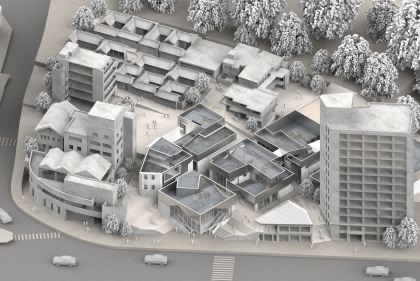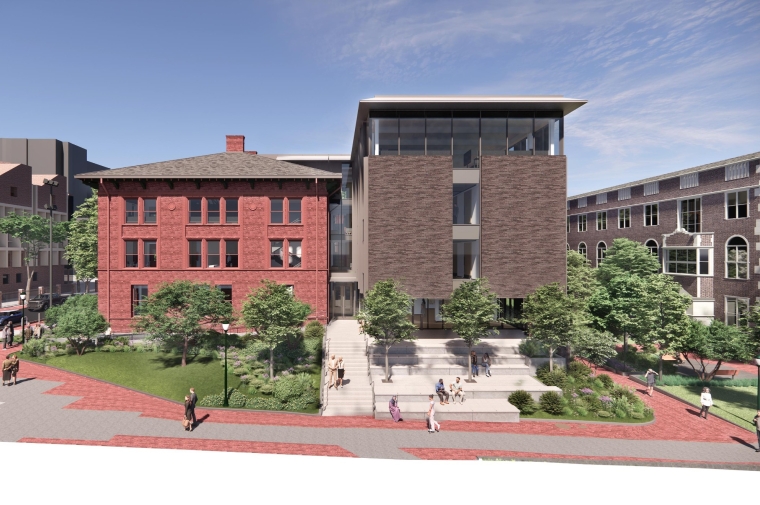August 27, 2025
Stuart Weitzman School of Design
102 Meyerson Hall
210 South 34th Street
Philadelphia, PA 19104
Get the latest Weitzman news in your Inbox
Weitzman has selected Marina Tabassum Architects (MTA), the Bangladeshi architecture firm whose Serptentine Pavilion 2025: A Capsule in Time was completed earlier this year, to receive the 2025 Kanter Tritsch Medal in Architecture, and the Green Heart Louisville Project, the University of Louisville’s groundbreaking scientific study of the benefits of trees and shrubs on human heart health, to receive the 2025 Witte-Sakamoto Family Medal in City and Regional Planning. The awards will be presented at a public ceremony featuring lectures by the honorees on Wednesday, November 12, 2025.
“The work of Marina Tabassum Architects dazzles not just formally but also culturally and environmentally,” said Fritz Steiner, dean and Paley Professor at Weitzman, and a member of the juries. “Green Heart Louisville exemplifies a holistic way of looking at public health—a marriage of design, planning, and science to emulate.”
The Kanter Tritsch Medal in Architecture was established in 2017 through a gift from Weitzman alumna Lori Kanter Tritsch (MArch’85), a member of the Board of Advisors at Weitzman. The Medal honors an architect or firm that has changed the course of design history with a particular focus on the areas of energy conservation, environmental quality, and/or diversity.
The Witte-Sakamoto Family Medal in City and Regional Planning was established in 2019 by William Witte (C‘73, MCP‘75), an alumnus of the Weitzman School, and his wife, Keiko Sakamoto, to recognize a firm, team, or professional for an exemplary plan that advances the field of plan making in at least four of the following areas: social equity, environmental quality, design, public health, mobility, housing affordability, and economic development.
Previous medalists include Tod Williams and Billie Tsien (2018); A. Eugene Kohn (2019); Regional Plan Association for the Fourth Regional Plan (2019); Peter Eisenman (2020); the City of Philadelphia forGreenPlan Philadelphia (2020); MASS Design Group (2021); the City of Minneapolis for Minneapolis 2040 (2021); Diller Scofidio + Renfro (2022); Suisman Urban Design and iQuilt Partnership for Hartford400 (2022); KoningEizenberg (2023) and James Corner Field Operations for Reimagine Middle Branch (2023); SANAA (2024); the City of Charlotte, for the Charlotte Future 2040 Comprehensive Plan (2024).
In conjunction with the professional medals, the Weitzman School selected two outstanding students entering their final year of study to receive a $50,000 scholarship each. The recipient of the 2025 Kanter Tritsch Prize in Energy and Architectural Innovation is Junxi Liu (MArch’26) and the recipient of the 2025 Witte-Sakamoto Family Prize in City and Regional Planning is Anaushka Goyal (MCP’26). In addition, Jonathan Bonezzi (MArch’26) has received the Kanter Tritsch Second Place Prize in Architecture and a $10,000 scholarship for the 2025 - 2026 Academic Year. Liz Crouse (MCP’26) has received the Witte-Sakamoto Second Place Prize in City and Regional Planning and a $10,000 scholarship for the 2025 - 2026 Academic Year.
The juries for the Kanter Tritsch Medal and Prize were chaired by Rossana Hu, Miller Professor and chair of architecture at Weitzman and co-founding partner at Neri&Hu Design and Research Office. The juries for the Witte-Sakamoto Family Medal and Prize were chaired by Megan Ryerson, UPS Foundation Chair of Transportation, chair of city and regional planning, and professor of city and regional planning and electrical and systems engineering.
The Weitzman School Awards event will take place on Penn’s campus in Meyerson Hall, 210 South 34th Street, Philadelphia. Learn more about the honorees, past and present, on the Weitzman Awards website. Event registration will open September 4, 2025.
About Marina Tabassum Architects
Founded in 2005, Marina Tabassum Architects (MTA) is an internationally recognised architecture and studio-based practice located in Dhaka, Bangladesh. MTA began with the mission of establishing a language of architecture that is relevant to the contemporary world yet rooted in location. The firm’s work has been widely praised as environmentally conscious, socially responsible, and historically and culturally appropriate. MTA invests heavily in understanding the impacts of climate change in Bangladesh, working closely with geographers, landscape architects, planners and other allied professionals. MTA prioritizes marginalised and low- to ultra-low-income communities, with a goal to elevate the environmental and living conditions of people.
MTA has completed work for numerous institutions across Bangladesh and internationally. In 2016, the firm received the Aga Khan Award for Architecture for the Bait Ur Rouf Mosque–a building distinguished by its lack of popular mosque iconography, an emphasis on space and light and its capacity to function as a place of worship and also a refuge for the dense neighbourhoods on Dhaka’s periphery. The project was listed among the top 25 postwar buildings of the world by The New York Times. In 2025, MTA received the second shortlisting for the Aga Khan Award for Architecture for the Khudi Bari, a product of self-initiated research that is now housing displaced marginalised communities in the sandbeds of the Ganges delta. Made with bamboo, the Khudi Bari structure was scaled up to serve as community centres in the refugee camps in Cox’s Bazar housing more than one million forcefully displaced Rohingyas.
MTA’s Serpentine Pavilion: A Capsule in Time, commissioned by London’s Serpentine Gallery, is on view there through October 26. MTA’s works are currently the subject of a monographic travelling exhibition organized by Architektur Museum der TUM, Munich, that will be on view at TOTO Gallery Ma, Tokyo, from November 21, 2025 – February 15, 2026. Marina Tabassum: Architecture, My Journey, the first monograph of MTA, was published by ArchiTangle in 2023.
About Green Heart Louisville Project
The Green Heart Louisville Project is a groundbreaking scientific study that is testing the hypothesis that introducing more green trees and shrubs into a neighborhood can directly lower the risk of cardiovascular disease (CVD), the leading cause of death worldwide.
Launched in 2018 by the Christina Lee Brown Envirome Institute at the University of Louisville with support from The Nature Conservancy, the study investigates whether and how living among more densely greened surroundings contributes to better heart health. The Green Heart team applied the treatment—the addition of thousands of mature trees and shrubs—to the center of a four-square-mile area in south Louisville. Announced in August of 2024, the first clinical outcomes from the study indicate that people living in neighborhoods where the number of trees and shrubs was more than doubled showed lower levels of a blood marker of inflammation than those living in the control area. General inflammation is an important risk indicator for heart disease and other chronic diseases.
The Green Heart Project’s work to establish a scientific link between nature—specifically urban greenery—and human health is already influencing projects worldwide. The first clinical outcomes announcement garnered widespread national media attention. Many research papers, posters and talks on the project have been delivered to both scientists and laypeople since the project’s inception with additional research and outreach to come in the years ahead.


 View Slideshow
View Slideshow



